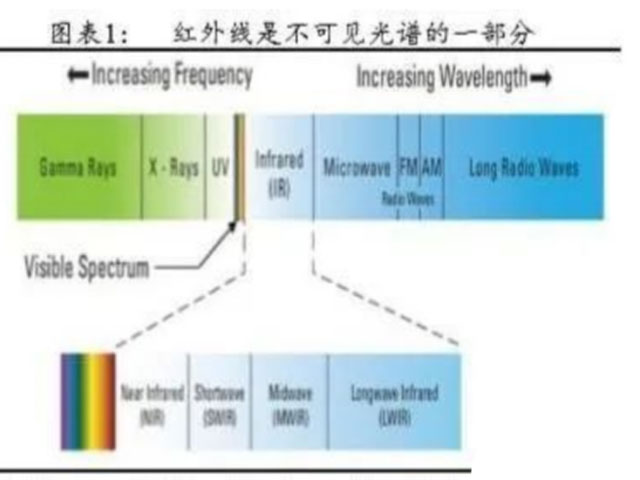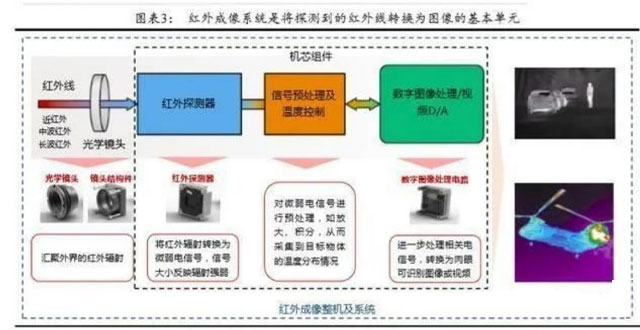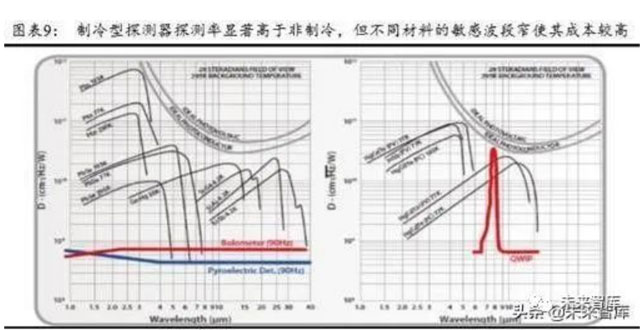In-depth research report on infrared detector industry
2022-03-03
1. The photoelectric conversion mechanism and material differences determine the cost and performance of infrared detectors
1.1 The focal plane array that detects specific wavelengths and realizes photoelectric conversion is the core of the infrared detector
The mechanism that objects above absolute zero will radiate infrared rays outward is the basis for the use of infrared to realize the detection function. Infrared is one of many invisible rays, also known as infrared light, infrared thermal radiation, and its wavelength is between microwave and visible light. In theory, all objects with a temperature higher than absolute zero (-273°C) will radiate infrared rays, which constitutes the premise for the wide application of infrared detection systems in the military and civilian fields. At present, the mainstream infrared imaging system generally chooses the thermal infrared ray of 3~5μm and 8~14μm which is not easily absorbed by the atmosphere as the main working band. The wavelength band is called long-wave infrared detector. Different detection targets have different radiation characteristics, and the selected detector needs to be comprehensively considered according to the target radiation temperature, background radiation environment, detection distance and other factors.

The infrared imaging system converts the detected thermal infrared into images, and the infrared detector is the core component of the system. The infrared imaging system is used to detect the infrared radiation of the target and convert it into a temperature distribution image or video. The main components include an infrared optical system, an infrared detector, a digital image processing circuit and algorithm, and a mechanical structure. The infrared detector is the core component of the infrared imaging system, the main body is an infrared focal plane array, and the focal plane array is used for photoelectric conversion. The infrared focal plane array is composed of a series of N*M working units (also called pixels), and each working unit is composed of an infrared detection unit and a ROIC readout circuit unit. The infrared detection unit on the upper layer uses specific sensitive materials to absorb infrared radiation and produce changes in corresponding physical properties, thereby generating weak electrical signals; the readout circuit unit on the lower layer is responsible for reading the corresponding electrical signals and performing preliminary signal processing. The focal plane array integrates the dot matrix infrared detection array and the ROIC readout circuit array, and is packaged together in a housing, and photoelectric conversion and signal preprocessing can be realized on the focal plane array.

1.2 The difference between the photoelectric effect and the thermal effect mechanism determines the difference in performance between refrigeration and non-refrigeration
According to the different physical principles applied in the photoelectric conversion process of the focal plane array working unit, infrared detectors can be divided into photon detectors and thermal detectors. The photon detector is based on the photoelectric effect. After the detector absorbs photons, the electronic state of the sensitive material changes. By measuring the photoelectric effect, the number of absorbed photons can be determined, and then the target infrared radiation distribution can be obtained. The thermal detector is based on the change of physical properties (such as resistance change) of the temperature-sensitive material after the temperature rises. By measuring the change of these physical properties, the infrared radiation energy absorbed by the detector can be determined, and the infrared radiation distribution of the target can also be obtained. The difference in imaging mechanism is the core of the difference in performance. Photon detectors based on the photoelectric effect can instantaneously generate photoelectrons after receiving infrared radiation of a specific frequency, and the general system response time is nanoseconds; thermal detectors based on the pyroelectric effect require a heating process after receiving infrared radiation, and the response time is In milliseconds, the two types of detectors differ by many orders of magnitude in response time. At the same time, the excitation of the photoelectric effect only requires radiation of a specific frequency, and there is no requirement for the radiation intensity; the thermoelectric effect can only produce changes in the physical properties of materials that can be accurately measured after the radiation reaches a certain intensity. The index of reaction sensitivity is also significantly better than uncooled.
The two types of detectors use different sensitive materials and correspond to different operating temperatures, so photon detectors are also called refrigerated detectors, and thermal detectors are called uncooled detectors. Based on different physical principles, two types of detectors have developed a variety of sensitive materials with different properties in recent years. Among the various sensitive materials for photon detectors, mercury cadmium telluride is the most widely used. Quantum wells (QWIPs), quantum dots, and superlattice materials have also developed rapidly in recent years. The above sensitive materials generally work in a low temperature environment. For example, the effective working temperature of the mercury cadmium telluride material suitable for the middle band is 200K (-73°C). When the detector is cooled to 77K, the response band of the material can be extended to 3~5μm. Only near absolute zero spectral effects can exceed 8μm, so photon detectors need to be equipped with coolers, also known as cooled detectors. The application of the refrigerator also determines the large volume, high power consumption and short life of the refrigeration detector. Among the sensitive materials for thermal detectors, vanadium oxide and amorphous silicon are the most widely used. According to "Recent progress in HgCdTe infrared detector technology" published by Antoni Rogalski in 2011, the global market share of uncooled detectors using vanadium oxide materials is 70%, while that of polysilicon is 17%. Because these materials work in the normal temperature environment and do not need a refrigerator, the thermal detector is also called an uncooled detector.
Due to the high cost of sensitive materials, narrow operating band, and high cost of the refrigeration system, the use cost of the refrigeration type is much higher than that of the non-refrigerated type. Refrigerated main sensitive materials such as mercury cadmium telluride and new quantum materials are difficult to grow and have low yields during the preparation process, resulting in higher prices than uncooled common sensitive materials. The stable and measurable photoelectric effect of different materials of the cooling type is only concentrated in part of the wavelength band, resulting in a narrower applicable band for the common cooling type. The detection tasks of different wavelength bands require the use of multiple cooled detectors or more expensive multi-band cooled detectors. detector. The response of the uncooled type is the temperature rise change, which is independent of the frequency, so a single thermal detector can basically cover the entire infrared band and complete the detection task of each band. Refrigeration type refrigerators require fast cooling, stable performance and high reliability, so the manufacturing cost is relatively high.

1.3 The improvement of cooling type is mainly based on materials, while the non-cooling type focuses on reducing pixels and improving packaging
On the whole, infrared detectors are developing in the direction of increasing the size of the focal plane array, and reducing the pixel size and pixel spacing. Increasing the array scale and pixel density can greatly improve the detection and imaging capabilities of the detector without enlarging the detector volume. The reduction of the pixel size and pixel spacing can significantly increase the array density, and the pixel spacing can be reduced. It also saves raw materials and reduces the cost of detectors. At the same time, the technological change of the optical system helps to improve the detection performance. For example, the field of cooling is currently moving towards variable F-number lenses (to take full advantage of the high sensitivity and large area array of cooled detectors), dual-band lenses (to simultaneously receive infrared radiation in both medium and long wavelength bands through dual apertures, enabling the system to obtain The development of dual-band detection capability); in the uncooled field, in order to better utilize the detector performance, it is necessary to adapt to different lenses. According to "Progress and Prospects of Infrared Imaging Optical Systems", with the substantial reduction in size and weight, uncooled detectors have There is an increasing demand for miniature infrared lenses with optical paths less than 1/2 focal length. Infrared detectors with different pixel sizes need to match different lenses. Take Sunny Technology, a large domestic infrared lens supplier, as an example. The infrared lens products sold on its official website are mainly for 12μm and 17μm infrared detectors. It is expected that with the accelerated development of lenses such as 10μm in the future, infrared manufacturers with more advanced detectors may benefit first, and the market share may continue to expand.
The main development line of refrigeration detectors is to improve the preparation process of mercury cadmium telluride, the research and development of new quantum materials, and other supporting technologies (including refrigerator technology and packaging technology). For example, photosensitive materials serve as the basis for photoelectric conversion of detectors, and their performance improvements have always been the main driving force for the performance improvement of photonic infrared detectors. At the same time, advances in other auxiliary technologies also contribute to the improvement of detector performance. The main line of non-cooling development is to focus on core technologies to reduce costs and improve performance under this premise, which is reflected in the preparation and processing of heat-sensitive materials, the structure design and manufacture of infrared MEMS sensors, the design and manufacture of CMOS readout circuits, and ceramic packaging. , wafer-level packaging and other advanced packaging technologies. For example, in terms of improving packaging methods, although wafer-level packaging has a large initial investment, it is suitable for mass production and can greatly reduce packaging costs. At present, China is still in the transition period from metal packaging to ceramic packaging. It is expected that the penetration rate of ceramic packaging will be in the short term. Will gradually increase, or will significantly reduce the cost of domestic detectors.
2 Differences in demand elasticity lead to different driving forces between military and civilian
2.1 The detector is the core of the infrared industry, and most companies that master the self-control ability achieve full coverage
The essence is the chip manufacturing industry, supply drives demand, and the performance and cost of upstream detectors lead to differences in their application fields. In essence, the infrared industry chain can be compared to the chip manufacturing industry, and the most upstream detector is the core of the entire industry chain. Among them, MEMS chips that integrate CMOS readout circuits and MEMS sensor wafers are mostly manufactured in Fabless mode (that is, infrared manufacturers outsource chip manufacturing). Combined with the difference in packaging technology, the performance of detectors developed by various manufacturers is quite different. In addition, due to the large difference in performance and price between uncooled and refrigerated types, refrigerated detectors with high price and excellent performance are mostly used in high-end military, such as airborne, shipborne, vehicle-mounted optoelectronic systems and infrared-guided missiles. With the continuous reduction of the detector pixel size and the continuous improvement of packaging technology, the cost of uncooled infrared manufacturing has gradually decreased, and new civilian market application fields have been continuously developed, such as outdoor, fire protection, and assisted driving. With the improvement of detection accuracy, portable individual equipment, such as night vision devices, gun sights, and anti-tank portable missiles, has gradually become the main application field of low-cost uncooled infrared. In terms of links, most companies that master the self-made detectors have achieved full chain coverage. Upstream of the industry chain, infrared chips are the core components of detectors. The infrared chip is packaged to form an infrared detector, and the performance of the infrared detector largely determines the performance of the infrared imaging system. Compared with the high threshold of chip manufacturing design technology and manufacturing process, the image processing circuits and algorithms emphasized in the core part, and the combination of the whole machine part and the application field are relatively low threshold, so that enterprises that master the self-made detectors generally realize the whole process. cover. For example, Ruichuang Micro-nano (58.800, -1.43, -2.37%), which has the leading research and development capability of uncooled detectors in China, has now achieved full coverage, not only for exporting self-made detectors, but also for outdoor sports handheld thermal imaging of the whole machine. Instrument sales have also achieved rapid growth in the past two years. At the same time, as mentioned above, germanium lenses, germanium windows, etc. are an important part of the infrared industry chain. Although some domestic infrared companies have the ability to partially manufacture lenses, the lenses suitable for higher specification detectors are still more professional optics. For example, the largest supplier of lenses provided by glass manufacturers in 2018 for Ruichuang Micro-nano is Sunny Infrared, a large-scale domestic company.
2.2 Low demand elasticity/technology-driven core military products, high demand elasticity/cost-driven individual soldier + civilian products
Core military products are reflected in low demand elasticity, and individual soldier + civilian products are reflected in high demand elasticity. (1) In the high-end military product market, which is the main application field of refrigeration detectors, because infrared technology is relatively irreplaceable in high-end military products represented by guided missiles, airborne sensing, and shipborne sensing, the military's interest in such products is relatively irreplaceable. Price sensitivity is low, and technology is the main competitive factor in this market. (2) In the main application field of uncooled detectors, the individual soldier + civilian infrared market, due to the large demand in this market and the large difference in the price of a single product compared with the core military products (for example, in 2018, the global infrared leader FLIR's machine The price of the sensor system is more than 1 million US dollars, while the individual equipment has dropped to less than 1,000 US dollars), market players will first focus on the technical competition at the level of detector pixel size and packaging technology, and the upgrade of such technologies will Significantly reduce product costs, and the reduced costs will further open up more civilian application areas, thus leading this market segment to evolve into cost competition.
 tel
tel


